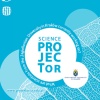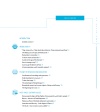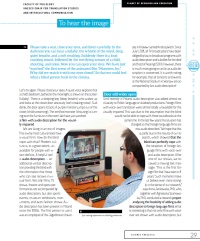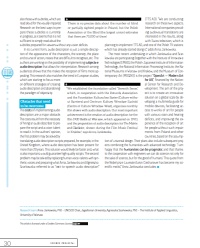Usłyszeć obraz

W drugim numerze Projektora nauki (2014) publikowanym przez Uniwersytet Jagielloński znajduje się artykuł pt. To hear the image.
Zapraszamy do lektury!

FACULTY OF PHILOLOGY
UNESCO CHAIR FOR TRANSLATION STUDIES AND INTERCULTURAL COMMUNICATION
Please take a seat, close your eyes, and listen carefully. In the darkness you can hear a lullaby, the whistle of the wind, deep, quiet breaths, and a soft creaking. Suddenly there is a loud cracking sound, followed by the terrifying scream of a child, shouting, and noise. Now you can open your eyes. We have just "watched" the first scene of the animated film "Monsters, Inc." Why did we watch it with our eyes closed? So that we could feel what a blind person feels in the cinema.
Let's try again: Please close your eyes. A quiet voice explains that a child's bedroom, bathed in the moonlight, is shown on the screen (lullaby). There is a sleeping boy (deep breaths) who wakes up and looks at the closet door anxiously (soft creaking noise). Suddenly, the door opens (crack). A purple monster jumps out of the closet (child screaming). The terrified monster (shouting) is turning over the furniture in the room. We have just watched a film with audio description for the visually impaired.
We are living in an era of images. This is why most cultural texts have a visual form. How do the blind cope with that? Modern culture is, to a great extent, unavailable for people with vision deficits. A helpful tool is audio description — an additional verbal description providing the blind with the information that those who can see receive in visual form. Not only films, TV shows, theatre and opera performances are accompanied by audio description, but also sports events, museum exhibitions, monuments, and even fashion shows. Audio description has been present in Poland since the 1990s. The first person to use it was an employee of the Jagiellonian University in Kraków named Andrzej Woch. Since July 1, 2011, all TV broadcasters have been obliged by law to broadcast programs with audio description and subtitles for the deaf and hard of hearing (SDH). However, there is much more going on as far as audio description is concerned. It is worth noting, for example, that all concerts and events at the National Stadium in Warsaw are accompanied by live audio description!

Door still wider open
Until recently in Poland, audio description was added almost exclusively to Polish-language or dubbed productions. Foreign films with voice-over translation were almost totally unavailable for the visually impaired. This was due to the assumption that the blind would not be able to cope with three soundtracks at the same time. In the last few years this situation has changed so that foreign language films are now audio described. "We hope that this is partly due to the results of our research, which showed that the blind can perfectly cope with the reception of foreign language films with voice-over and audio description. After one of our shows, we received a moving text message: ‘This is the first foreign film that I have seen in 11 years.' Such moments make us believe even more strongly in the sense of our research," says Anna Jankowska, PhD, who, together with Agnieszka Szarkowska, PhD, conducted a research project analyzing the feasibility of adding audio description to foreign language films. What is interesting is that not only films with voiceover are shown with audio description, but also those with subtitles, which are read aloud for the visually impaired. Research on the best ways to prepare these subtitles is currently in progress, as it seems that it is not sufficient to simply read aloud the subtitles prepared for viewers without any vision deficits.
There is no precise data about the number of blind or partially sighted people in Poland, but the Polish Association of the Blind (the largest union) estimates that there are 73,000 of them!
In its current form, audio description is just a simple description of the appearance of the characters, the scenery, the place and course of action, noises that are difficult to recognize, etc. The authors are working on the possibility of implementingsubjective audio description that allows for interpretation. Research among audiences shows that this makes the reception of films more appealing. This research also matches the trend in European studies, which are starting to focus more on different strategies of creating audio description and abandoning the paradigm of objectivity.
Eye-tracking experiment on subtitling preferences

Obstacles that need to be overcome
The costs of implementing audio description are a major obstacle. The costs result from the necessity of hiring an audio describer to prepare the script and a voice-talent to read it. In the authors' opinion, the first problem may be solved by translating audio description scripts prepared, for example, in the United Kingdom, where audio description has been present for more than 20 years. This solution would likely be faster and, what is also important, would guarantee high quality scripts. The second problem may be solved by replacing human voice-talents with synthetic voices and preparing what Anna Jankowska and Agnieszka Szarkowska referred to as "text-to-speech audio description" (TTS AD). "We are conducting research on these two aspects. International companies providing audiovisual translations are interested in the results, along with Swiss television, which is planning to implement TTS AD, and one of the Polish TV stations which has already started doing it," adds Anna Jankowska.
"We established the foundation called "Seventh Sense," which, in cooperation with the Rotunda Association and the Foundation Kultura bez Barier (Culture without Barriers) and Centrum Kultury Wrocław-Zachód (Centre of Culture Wrocław-West), organizes monthly film shows with audio description. Our most important achievement is the creation of audio description for the film 1920 Battle of Warsaw, which appeared on DVD, and the preparation of audio description for The Matrix and Gladiator, shown during the Film Music Festival in Kraków," says Anna Jankowska.
The most recent undertaking in which Jankowska and Szarkowska are participating (together with the Institute of Innovative Technologies [EMAG], the Polish-Japanese Institute of Information Technology, the National Information Processing Institute, the National Museums in Warsaw and Kraków, and the Museum of Contemporary Art [MOCAK]) is the project "OpenArt — Modern Art for All," financed by the National Center for Research and Development. The aim of the project is to create an innovative solution on a global scale by developing a multimedia guide for mobile devices, facilitating access to works of art for people with various vision and hearing deficits, and improving the experience of the reception of art for people without such impairments from Poland and other countries, based on the assumption of universal design. Their plans also include subsequent projects combining the humanities with advanced technology. "I am happy that the humanities can be pragmatic and that thanks to the cooperation with engineers we can do science not only for the sake of science, but for the good of humans.' This quote from the Nobel prize Laureate Aaron Ciechanover has become my scientific motto," Anna Jankowska concludes.
Research team: Anna Jankowska, PhD – UNESCO Chair, Jagiellonian Univeristy; Agnieszka Szarkowska, PhD – The Institute of Applied Linguistics, University of Warsaw
Tekst pobrany ze strony http://www.projektor.uj.edu.pl/sp/planet-of-research-and-education/hear-image
Osoba publikująca: Monika Curyło

